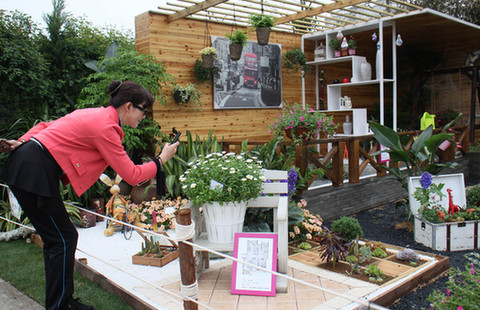China's rare earth boom comes at grim cost
(Xinhua) Updated: 2012-04-23 17:51NANCHANG - A green future made possible through the use of rare earth metals seems a world away from Zhang Yang'e, whose neighborhood well has become unusable as a result of local mining operations.
An unpleasant odor wafts from a well in Zhang's backyard, with the well's brownish-yellow water sitting beneath a tangle of spiderwebs.
"The water used to taste sweet and our neighbors all loved it. But now it has been become undrinkable," said the 73-year-old farmer, a resident of Dingnan county in east China's Jiangxi province.
"Even my vegetables withered after I watered them with well water," she said, referring to the rows of green onions, chives and peas she planted in her backyard.
Zhang has been forced to water her vegetables with tap water. The local government installed taps for her and seven other families in March last year, forcing them to pay an additional 20 yuan ($3.17) each month for clean water.
Zhang has blamed a rare earth mine located just 10 meters from her home for the poor quality of her well water. A green hill where the mine was built has been scraped and turned into a cratered landscape not unlike that of the moon, with piles of rock tailings nearly as high as Zhang's two-story house.
Trees on the hill have been toppled and topsoil has been removed. Chemicals have been pumped into holes drilled in the ground to help recover the rare earth metals located there, Zhang said.
Similar open-pit mines can be found dotting the densely wooded hillsides of Longnan county, which is about a half-hour drive from Dingnan. Plastic pipes and chemical holding tanks can be seen at the foot of the hills. Some of the tanks are filled with a bright blue liquid, while others contain a dark brown solution.
To exploit rare earth metals, some miners use a chemical extraction process that involves digging several holes of just a few feet in depth and feeding pipes into the holes. A concentrated mixture of chemicals is then pumped through the pipes, sinking into the clay below and leaching out rare earth metals as it passes.
It seems incredible that such a low-tech method is used to harvest minerals that are used in some of the world's most technologically advanced products. Rare earth metals are used to build components used in smart phones, wind turbines, electric car batteries and missiles.
China supplies more than 90 percent of the world's rare earth metals, but its reserves only account for about one-third of the world's total. Faced with widespread environmental challenges, the country has launched nationwide campaigns in recent years to clean up its mines.
However, these policies, including production caps, export quota cuts and stricter emission standards, have sparked concerns among foreign consumers.
On March 13, the United States, European Union and Japan teamed up to bring a joint case against China to the World Trade Organization over alleged export controls on rare earth metals, which they claim are hurting their own domestic manufacturers.
Zhang has heard nothing of the trade disputes. These days, she's more worried about the upcoming rainy season.
"When the rains come, the tailings are sometimes swept into the water, flooding our doorways and finally entering our streams," she said. "We don't know if this could cause any health problems."
In Dingnan, Longnan and other counties in the city of Ganzhou, red clay on the hillsides contains a high concentration of heavy rare earth metals that can be easily absorbed through the clay. Local farmers have mastered the art of using high-potency fertilizer to dissolve the clay and obtain the valuable minerals inside.
Although the Ganzhou government has ordered a shutdown of all rare earth mines since October as an effort to regulate the sector, it is not hard for smaller producers to elude the government's reach.
"It seems impossible to completely eradicate illegal mining, as rare earth elements are scattered almost everywhere in the red clay," said Yi Wenbin, deputy magistrate of Longnan county.
Statistics from Ganzhou's mine management bureau indicate that the bureau uncovered 52 instances of illegal rare earth mining in the first three months of this year.
"Although mining methods have been improved over the decades, environmental damage is still inevitable, especially for water supplies," said Zhang Xusheng, chief of Ganzhou's environmental inspection team.
Waste water from mining operations cannot be used for irrigation, even after being processed according to national emission standards, Zhang Xusheng said. He dodged a question about what might happen to people who live downstream from the mines, as many of them rely on rivers and streams for irrigation.
While eliminating new sources of pollution is challenging, cleaning up pollution from older sources is even more difficult. Rare earth mining began in Ganzhou in the 1970s, leaving much of the land scarred by barren tailing ponds and eroded hilltops.
At the Zudong rare earth mine in Longnan, an eight-million-yuan experimental project is being undertaken to reclaim some of the land, with the project's administrators mixing bags of soil with grass seeds and spreading the mixture on the ground to rehabilitate the barren land.
However, the cost of the seeds has proved to be rather high, according to figures provided by Liao Zhennan, director of Longnan's mine management bureau. One type of grass seed imported from the United States costs 80,000 to 100,000 yuan per mu (0.07 hectares) of coverage.
"The spending will multiply if you take the treatment of water pollution into consideration," Liao said.
According to Su Bo, deputy director of the Ministry of Industry and Information Technology, repairing the environmental damage in Ganzhou will cost a total of 38 billion yuan. By contrast, the province's rare earth industry only reaped 6.4 billion yuan in profits in 2011.
- US sets preliminary dumping rates on China's steel wire rod
- China to mass produce industrial robots
- Has the tide turned for Chinese stocks?
- East China province announces child product recall
- Aston Martin hires senior Nissan exec as chief executive
- China to cooperate with APEC on energy
- China's non-manufacturing PMI rebounds in August
- Capital Spirits: Beijing's first liquor bar

















